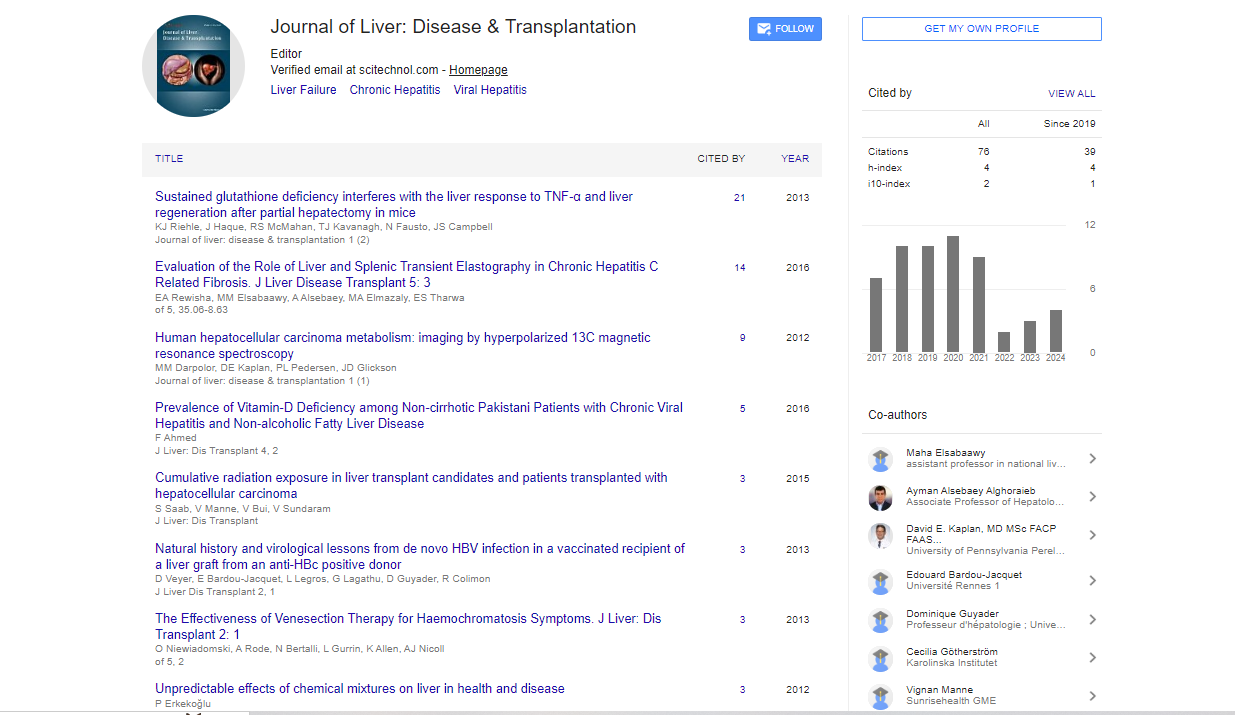Commentary, J Liver Disease Transplant Vol: 13 Issue: 3
Organ Preservation Techniques: Optimizing Liver Viability for Transplantation
Daniel Moore*
1Department of Hepatology, University of Melbourne, Melbourne, Australia
*Corresponding Author: Daniel Moore,
Department of Hepatology, University of
Melbourne, Melbourne, Australia
E-mail: daniel.moore@unimelb.edu.au
Received date: 26 August, 2024, Manuscript No. JLDT-24-151925;
Editor assigned date: 28 August, 2024, PreQC No. JLDT-24-151925 (PQ);
Reviewed date: 11 September, 2024, QC No. JLDT-24-151925;
Revised date: 18 September, 2024, Manuscript No. JLDT-24-151925 (R);
Published date: 25 September, 2024, DOI: 10.4172/2325-9612.1000278
Citation: Moore D (2024) Organ Preservation Techniques: Optimizing Liver Viability for Transplantation. J Liver Disease Transplant 13:3.
Description
Liver transplantation has become an essential treatment for patients with end-stage liver disease, acute liver failure and metabolic disorders. The liver, with its unique regenerative capabilities, is one of the few organs that can restore function after partial resection or transplantation. However, the success of liver transplantation depends heavily on the preservation of the donor organ before it is transplanted. As the demand for liver transplants continues to outpace the availability of suitable donor organs, optimizing liver preservation techniques has become an important area of study. Organ preservation aims to maintain organ viability outside the body, preventing cellular damage, preserving metabolic function and delaying irreversible injury until the organ can be transplanted into the recipient. For the liver, a highly vascularized and metabolically active organ, the window of preservation is particularly sensitive to ischemia (lack of blood flow) and hypoxia (lack of oxygen). Prolonged cold ischemia, which occurs when the organ is stored at low temperatures, results in a series of biochemical and cellular stresses that impair organ function and graft survival post-transplantation. Therefore, minimizing the time between donor organ retrieval and transplantation, while maintaining optimal preservation conditions, is essential for successful liver transplantation outcomes.
The most common method for preserving livers is hypothermic preservation, which involves cooling the organ to reduce its metabolic rate and oxygen consumption. This technique helps minimize ischemic injury by slowing the biochemical processes that lead to cellular damage. The liver is typically stored at temperatures ranging from 4°C to 10°C, either in cold storage solutions or in specialized preservation machines. Several cold storage solutions have been developed to support the liver during this period, with University of Wisconsin (UW) solution being one of the most widely used. UW solution is a balanced electrolyte solution that includes glucose, potassium and other compounds designed to protect cells from ischemic damage. Despite its widespread use, cold storage has limitations, including the inability to prevent long-term damage from Ischemia-Reperfusion Injury (IRI) that occurs when blood flow is reintroduced to the liver upon transplantation. Machine perfusion is a promising advancement in organ preservation, offering a dynamic and controlled environment that mimics physiological conditions. Unlike static cold storage, where the liver is stored in a preservative solution, machine perfusion involves the continuous circulation of a preservation solution through the liver’s vasculature. This method has been shown to improve liver function, reduce injury and even extend the allowable preservation time. There are two primary types of machine perfusion: Hypothermic Machine Perfusion (HMP) and Normothermic Machine Perfusion (NMP).
Hypothermic Machine Perfusion (HMP)
HMP involves perfusing the liver with cold preservation solution at temperatures around 4°C to 10°C. This technique offers several advantages over static cold storage, including better distribution of nutrients and oxygen to the liver cells, which can help prevent the accumulation of harmful metabolites. HMP has also been shown to reduce the incidence of ischemic injury, making it particularly useful for extended-criteria donor livers (those from older or marginal donors). Moreover, HMP has been associated with a higher rate of successful transplants and improved post-transplant graft function compared to static cold storage.
Normothermic Machine Perfusion (NMP)
NMP is an innovative method that involves perfusing the liver at normal body temperature, essentially keeping the organ "alive" outside the body. This technique has gained increasing attention due to its potential to simulate the organ's natural metabolic and functional conditions. NMP provides a more physiological environment, with continuous oxygen delivery and nutrient supply, thereby reducing the damage caused by ischemia-reperfusion injury. Additionally, it allows for real-time assessment of liver function, including bile production, metabolic activity and response to various stressors, which can guide decisions about the suitability of the organ for transplantation. NMP has shown promise in improving graft survival, particularly in cases where the liver has been subjected to extended cold ischemia times. The ability to assess liver function during perfusion also helps clinicians determine whether a marginal liver is viable for transplantation, reducing the risk of transplant failure.
Conclusion
Organ preservation is an important component of successful liver transplantation and optimizing preservation techniques is essential for improving graft survival and patient outcomes. Traditional methods like cold storage have served as the cornerstone of organ preservation for decades, but advances in machine perfusion, both hypothermic and normothermic, offer exciting opportunities to enhance liver viability. Furthermore, biochemical approaches to reducing ischemic and oxidative injury are paving the way for more effective preservation strategies. As the field continues to evolve, the development of more efficient preservation techniques will be instrumental in addressing the increasing demand for liver transplants and improving the quality of life for transplant recipients worldwide. Through innovation and continued study, the future of liver transplantation looks promising, with the potential to save countless lives and enhance the efficacy of this life-saving procedure.
 Spanish
Spanish  Chinese
Chinese  Russian
Russian  German
German  French
French  Japanese
Japanese  Portuguese
Portuguese  Hindi
Hindi 